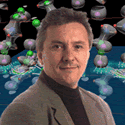 |
| |
|
Today

8
a.m. - 2 p.m.
BLOOD DRIVE
70A-3377 (Seaborg
Conference Room)
Tomorrow
8
a.m. - 2 p.m.
BLOOD DRIVE
70A-3377 (Seaborg
Conference Room)
Noon
SEMINAR
Environmental Energy Technologies
Energy Efficiency Indicators for High Electric-Load
Building
Bernard Aebischer, Center for Energy Policy &
Economics, Swiss Federal Institutes of Technology
Building 90-3148
1
p.m.
SEMINAR
Environmental Energy Technologies
Health-Relevant Outdoor Air Change Rates in
Home
Jan Sundell, Technical University of Denmark
Building 90-3075
1:30
p.m.
SEMINAR
Surface Science
And Catalysis
Synthesis and Characterization of Macrocyclic
Vinylaromatic Polymers
Thieo Hogen-Esch, University of Southern California
Bldg. 66 Auditorium
|
|
 |
|
 |
|
Java
Wave Schedule: |
| |
|
|
| Bldg.
65: |
 |
8-8:15
a.m. |
| Bldg.
88: |
|
8:20-8:35 a.m.
1:30-1:45 p.m. |
| Bldg.
90: |
|
8:45-10
a.m
12:55-1:25 p.m. |
| Bldg.
84: |
|
10:15-10:45
a.m.
12:30-12:45 p.m. |
| Cafeteria:
|
|
10:55-11:25
a.m. |
| Bldg.
76: |
|
11:30-11:45 a.m. |
| Bldg.
69: |
|
11:50-12:05 a.m. |
| Bldg.
66: |
|
12:10-12:25
a.m. |
|
|
| |
|
 |
| |
|
Soup:
Mushroom Bisque
Origins:
Short Ribs
Adobe
Cafe: Pasta Toss
Fresh
Grille: Fish Fillet Sandwich
Full
Menu
|
|
| |
| |
|
|
|
|
|

Issue
of February 10, 2003 |
 |
|
Computing
Power To
Forecast Earth's Future
Kenneth Terrel
|
 |
 |
|
| Simon |
|
What's the
best way to build a crystal ball? That's the challenge for designers
of supercomputers. So speedy they can perform trillions of calculations
per second, these machines can predict everything from how fast
global warming will raise sea level to the side effects of an
experimental drug… "It's the difference between being
able to project the movement of thunderstorms and the movement
of hurricanes," says Horst Simon, director of the
National Energy Research Scientific Computing Center. Full
story. |
|
 |


A
Signal UC May
Lose Los Alamos
Zachary Coile,
Chronicle
Washington Bureau
Wednesday, February 5, 2003
In another sign
the Bush administration may be preparing to strip the University
of California of its contract to manage Los Alamos National Laboratory,
Energy Secretary Spencer Abraham has ordered the creation of a blue-ribbon
commission to help decide when lab contracts should be opened to
competitive bidding. Abraham has said UC's 60-year role as manager
of Los Alamos is in jeopardy because of charges of theft, fraud
and mismanagement at the nation's premier nuclear weapons lab in
northern New Mexico.
Full story.
|
|

|

Longer
Telomeres
Linked To Longer Life
Want to live
longer? According to a new study, you should hope you're endowed
with ample stretches of DNA called telomeres at the ends of your
chromosomes. The study is the first to link telomere length to longevity
in humans and could yield new strategies for combating age-related
ills.
Full story.
|
|
 |
|
A
Deep-Sea Fix
For Climate Change
Betsy Carpenter
|
 |
 |
|
| Benson |
|
'These guys
are wacko!" was earth scientist Sally Benson's initial
reaction several years back when two prominent scientists gave
a talk about an answer to global warming that sounded too good
to be true. Why not simply bury it underground or in the ocean
depths? Today Benson heads a U.S. Department of Energy effort
to explore just that idea, which is seeming less wacky every
day.
Full story. |
|
 |

If
You Hear Sirens
Today, Don’t Panic
The Cal Alert
and Warning System, to be tested on campus the first Wednesday of
every month, will sound for the first time today at noon. The county-wide
system is a network of safety sirens and communications links that
warn and inform the community of what to do in an emergency or disaster.
Hazards that could activate the system include chemical spills,
flooding, fires, storms, power outages, transportation incidents,
and other public safety crises.
Full story
|
|

